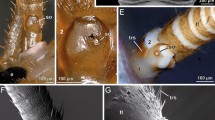Abstract
All scorpions have two mid-ventral organs called pectines. Each pecten has thousands of pore-tipped sensilla sensitive to a variety of volatile organic and water-based stimulants. However, it was previously unknown whether individual sensilla were functionally identical or different. The information enhancement hypothesis predicts that all sensilla have similar chemosensitivities such that each is a unit of a parallel processing system. The information segmentation hypothesis states that sensilla differ in their chemosensitivities, a functional arrangement akin to the glomeruli-specific chemical detection system in the moth or human olfactory sense. In this study, we tested these hypotheses by extracellularly tip-recording sensillar responses to three aqueous tastants: 0.01 M KCl, 0.1 M citric acid, and 40% ethanol by volume. We isolated stimulation to one sensillum at a time and compared the chemoresponses. Sensilla appeared to respond similarly to the same stimulant (i.e., sensillar tip-recordings revealed activity of the same cell types), although sometimes a few sensilla responded with higher spike rates than the others. We conclude that our data primarily support the information enhancement hypothesis but for future tests of sensillar function we suggest a new hybrid model, which proposes that a few specialized sensilla exist among a mostly uniform field of identical sensilla.







Similar content being viewed by others

References
Benton TG (2001) Reproductive ecology. In: Brownell PH, Polis GA (eds) Scorpion biology and research. Oxford University Press, New York, pp 278–301
Brownell PH (1998) Glomerular cytoarchitectures in chemosensory systems of arachnids. Ann NY Acad Sci 855:502–507
Brownell PH (2001) Sensory ecology and orientational behaviors. In: Brownell PH, Polis GA (eds) Scorpion biology and research. Oxford University Press, New York, pp 159–183
Carthy JD (1966) Fine structure and function of the sensory pegs on the scorpion pecten. Experientia 22:89–91
Derby CD, Steullet P (2001) Why do animals have so many receptors? The role of multiple chemosensors in animal perception. Biol Bull 200:211–215
Foelix RF, Müller-Vorholt G (1983) The fine structure of scorpion sensory organs. II. Pecten sensilla. Bull Br Arachnol Soc 6:68–74
Gaffin DD, Brownell PH (1992) Evidence of chemical signaling in the sand scorpion, Paruroctonus mesaensis (Scorpionida:Vaejovidae). Ethology 91:59–69
Gaffin DD, Brownell PH (1997) Response properties of chemosensory peg sensilla on the pectines of scorpions. J Comp Physiol A 181:291–300
Gaffin DD, Brownell PH (2001) Chemosensory behavior and physiology. In: Brownell PH, Polis GA (eds) Scorpion biology and research. Oxford University Press, New York, pp 184–203
Gaffin DD, Walvoord ME (2004) Scorpion peg sensilla: are they the same or are they different? In: Proceedings of the 3rd scorpiology symposium (Am Arachnol Soc, Norman, OK, 24 June 2004). Euscorpius 17:7–15
Knowlton ED, Gaffin DD (2009) A new approach to examining scorpion peg sensilla: the mineral oil flood technique. J Arachnol 37:379–382
Knowlton ED, Gaffin DD (2010) A new tip-recording method to test scorpion pecten chemoresponses to water-soluble stimulants. J Neurosci Methods 193:264–270
Melville JM, Tallarovic SK, Brownell PH (2003) Evidence of mate trailing in the giant hairy desert scorpion, Hadrurus arizonensis (Scorpionida, Iuridae). J Insect Behav 16:97–115
Wolf H (2008) The pectine organs of the scorpion, Vaejovis spinigerus: structure and (glomerular) central projections. Arthropod Struct Dev 37:67–80
Acknowledgments
We thank Matthew Taylor and Drs. Mariëlle Hoefnagels, Douglas Mock, and Rosemary Knapp for their help in preparing this manuscript. We also thank the Life Fund of the University of Oklahoma Foundation and the OU Zoology Adams Scholarship Fund for supporting this work. All experiments comply with standards for the ethical treatment of animals.
Author information
Authors and Affiliations
Corresponding author
Rights and permissions
About this article
Cite this article
Knowlton, E.D., Gaffin, D.D. Functionally redundant peg sensilla on the scorpion pecten. J Comp Physiol A 197, 895–902 (2011). https://doi.org/10.1007/s00359-011-0650-9
Received:
Revised:
Accepted:
Published:
Issue Date:
DOI: https://doi.org/10.1007/s00359-011-0650-9




